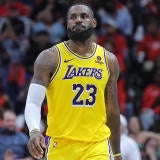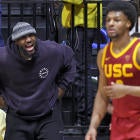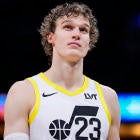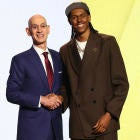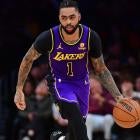
Rob Dillingham was widely expected to be drafted in the top 10 on Wednesday, and sure enough, he went at No. 8 overall. What nobody saw coming was the team that drafted him. It wasn't a lottery team. No, the Minnesota Timberwolves, who just came three games away from the NBA Finals, just jumped all the way up to No. 8 to land a possible cornerstone young piece out of nowhere. The Spurs, meanwhile, walked away with an unprotected 2031 first-round pick and a protected 2030 first-round swap.
Such a move is basically unprecedented in draft history. Sure, teams will trade lottery picks for future picks from time to time, but 2031 is seven years away. Meanwhile, the Timberwolves, a team ostensibly in win-now mode, just took a huge swing on a one-and-done college player. So what's going on here? Why did these teams make this trade? Well, let's grade it and explain the thought process for both sides. In short: this is a win-win deal.
Minnesota Timberwolves: A
Is Rob Dillingham going to be a major contributor to Minnesota's 2025 championship push? Probably not. Rookie guards are almost never good enough to help win-now teams at the highest levels. Dillingham is small and needs to work on his body. He has to grow as a passer before he can even be called a point guard, though for what it's worth, the demands of that position in Minnesota are going to be lower than they would elsewhere because of how often Anthony Edwards handles the ball. This is a longer-term pick for Minnesota.
That might seem unconventional given where they are, but remember, Mike Conley is 36. He's not going to be around forever. Minnesota needed to find a long-term replacement somehow, and they are hampered by the second luxury tax apron. Their ability to add proven, NBA talent is minimal right now. Could they have tried to pick a Conley replacement at No. 27? Sure. But what are the odds they would have found one there? Even in a normal draft, starters rarely fall to the late 20's. In this weak draft, it simply wasn't going to happen.
In Dillingham, the Timberwolves have not only found a possible long-term starter, but potentially a star. Dillingham's upside given his overall offensive game and athleticism is as high as any prospect's in the draft. He might need a few years to develop, and he may not be a conventional point guard like Conley, but think about the ages of some of Minnesota's key players. Edwards is 22. Jaden McDaniels is 23. Naz Reid is 24. Eventually, the Timberwolves are probably going to have to cut bait on either Rudy Gobert or Karl-Anthony Towns. Potentially both of them. That is just the reality of the second-apron NBA. The Edwards-McDaniels-Reid trio was their long-term core. Now they've added a fourth piece to that group, and all four of them are young enough to figure out the fit as they go.
If Dillingham pans out, the Timberwolves could contend for titles well after Towns and Gobert have aged out of their primes. Given their financial constraints, the picks it already owes to the Jazz and the rarity with which prospects like Dillingham ever get traded, Minnesota was never going to get another chance at a home run swing like this. The Timberwolves took it. If things go south in the interim, that 2031 pick might wind up being very high, but if that's the case, well, they're already in for a penny. Might as well stay in for a pound. They're getting a very high pick here in Dillingham, and given where this team is, it makes far more sense for them to take the player now as opposed to waiting seven years for a complete unknown.
San Antonio Spurs: A
Most teams use draft night to build for the next few years. The Spurs, with Victor Wembanyama in tow, are taking a much longer view. Over the past few years, they have slowly assembled a deep war chest of draft picks well into the future. A 2028 pick swap with the Celtics. A 2030 swap with Dallas. Now, another 2030 swap as well as an unprotected pick from the Timberwolves in 2031. Throw in the 2025 and 2027 picks the Spurs have from Atlanta, the 2026 swap the Hawks owe them and the protected pick eventually coming from Chicago thanks to the DeMar DeRozan trade and suddenly, the Spurs are set up to control at least one of another team's first round pick in every draft from now until 2031 with the exception of 2029.
Why is this so important? As with roster-building stories these days, the answer is the second apron. The Spurs want to win around Wembanyama indefinitely. This is the team that won 50 games 18 years in a row during the Tim Duncan era. They were never going to go all-in on a single, brief stretch. No. Rather, the Spurs have determined that the path to indefinite winning in the second apron era is to perpetually cycle in new, cheap rookies with the high-upside picks they've accumulated from other teams. After all, if Wembanyama is as good as we all expect, their own picks will be at the bottom of the first round.
Think about where the Spurs are today. Could Dillingham have become a core piece for them? Sure. But frankly, the Spurs have enough immediate young talent as it is. They already need to find minutes and shots for Wembanyama, No. 4 pick Stephon Castle, Devin Vassell, Jeremy Sochan, Keldon Johnson and the entire young group from last season. With so many more picks incoming and cap space to spend on veterans, they didn't want yet another high draft pick getting lost in the developmental shuffle.
Now think about where the Spurs will be in 2031. Wembanyama will probably be on a super-max contract by then. Presumably, at least one other young Spur will have developed into an expensive All-Star. At that point, they'll be dying for another cheap youngster. Could that Minnesota pick be late in the first round? Sure. If Edwards is there and happy, the Timberwolves could still be quite good. That four-man core we covered above could still be winning seven years from now.
But think about how long seven years really is. Seven years ago, Kyrie Irving was just coming off of his third straight trip to the NBA Finals with the Cleveland Cavaliers. Who would have guessed that he would have changed teams three times since then? Seven years is an eternity in the modern NBA. Edwards could grow dissatisfied at any point in that time span and force his way out. If he does, that pick becomes incredibly valuable.
Now consider those other picks San Antonio controls in the future. Dallas also has a young star in Luka Doncic. Boston has two in Jayson Tatum and Jaylen Brown. Atlanta thought it had one in Trae Young when it paid a king's ransom for Dejounte Murray. The Spurs have intentionally attempted to short these teams figuring that recent NBA history suggests that at least some of them will combust as Irving's Cavaliers did. They are, essentially, buying a number of lottery tickets hoping that a few of them hit. And if they do? The Spurs will be able to surround Wembanyama with high draft picks for, essentially, the entire first half of his career at least.
Oklahoma City has adopted a similar strategy and has even taken things a step further by trading outright picks for future swaps. The Spurs and Thunder are two of the smartest teams in the NBA, and they have adapted to the second apron before the rest of the league has caught up. They understand that you can't expect to keep a group of four or five ultra-expensive players together forever. If you want to contend indefinitely, you have to be maneuverable. You have to have a constant stream of draft picks incoming to replace the players that the second apron costs you.
The Spurs may well have given Minnesota a young star in Dillingham, but he's a player they ultimately decided they'd rather try to get when Wembanyama is 27 than when he is 20. They've refused to invest too heavily in a single crop of young players and are now positioned to build and rebuild winners around him for the next decade to come.
So was the price high? Sure, especially since Minnesota will soon be competing with San Antonio atop the Western Conference. But the Spurs have a plan and they're sticking to it. This trade was the just the most extreme example of the approach they've taken for the past two years.



